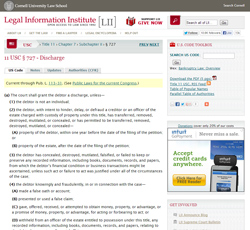In the previous installment of our series “Basics of Bankruptcy,” we discussed some of the reasons to file a Chapter 13 bankruptcy rather than Chapter 7 as they relate to mortgages.
This post looks at reasons why Chapter 13 might be the better choice for personal bankruptcy than Chapter 7 in relationship to cars and other personal collateral.
Cramming a Car
Summary: Provisions exist that can exclude any vehicle acquired for personal use or any other personal property purchased within 910 days of filing.
The ability to cram a recently purchased vehicle (or other personal property) has been limited by the BAPCPA (Bankruptcy Abuse Prevention and Consumer Protection Act) amendments (11 U.S.C. §§ 526–528 (2006)1), referred to as the 910-Rule). The unnumbered (hanging) paragraph at the end of §1325(a)1 excludes any vehicle acquired for personal use or any other personal property purchased within 910 days of filing from the application of §506.
In short, this means that if the personal automobile was purchased within 910 days of the filing date, the claim may not be bifurcated and the entire payoff balance shall be the secured value. However, because Section 1325(a)(5) gives debtors three options for confirmation of secured claims (creditor’s acceptance of the plan, satisfaction of enumerated terms, or surrender of the collateral), arguably, if the plan provides for the payment of only the fair market value for a 910 claim, and the creditor fails to object, upon confirmation the creditor is deemed to have accepted the plan and is bound by the terms of the plan.
In the past when cramming a car in a plan, it was advisable to include language that required that the title be released upon payment of the value offer. However, pursuant to the revised §1325(a)(d)(B), a secured creditor may object and the plan can not be confirmed unless the secured claim holder retains their lien until the debt is paid in full or the case is discharged.
However, because paragraph (5) gives three options (acceptance, satisfaction of enumerated terms, or surrender), arguably, if the plan specifies that title will be released upon payment of the secured portion of the claim, and the creditor fails to object, upon confirmation the creditor is deemed to have accepted the plan and is bound by the terms of the plan.
If a value agreement cannot be reached at the §341 meeting, the matter will be set over for a hearing before the Court. The Courts have generally favored concrete evidence of the value, but have recently indicated a willingness to look at “book” values, preferring the NADA guide.
Cramming other personal property
Summary: In an attempt to keep personal property, debtors may, within one year of filing, offer the fair market value on virtually any piece of personal property, including furniture, appliances and boats.
Subject to the same hanging paragraph limitation addressed above, debtors may offer the fair market value on virtually any piece of personal property, including furniture, appliances and boats. For any other collateral acquired for the personal use of the debtor, however, the time limitation is lowered from 910 days to one year.
- If no objections are received, the trustee will pay the value offer with interest, and will treat the remaining balance of the claim as unsecured.
- Interest should be offered as §1325(a)(5) requires that the creditor must receive “present value” of the collateral.
- However, it would seem that if interest were not offered and the creditor failed to object, the value could be paid at a flat rate (no interest).
Use caution when “cramming” the debtor’s personal property in a plan however, as the “Best Efforts” test will have some bearing. That is, if the debtors are attempting to retain collateral that is not “reasonable and necessary” as contemplated by §1325(b), the trustee may raise an objection to the utilization of estate funds to retain an unnecessary item. This objection may be resolved by either a surrender of the collateral in question, or by a modification of the plan that will increase the amount offered to general creditors by the amount of funds necessary to retain the property.
Some items that may merit a trustee’s best efforts objection include additional or luxury cars, a big screen TV, a boat, or a baby grand piano.
Lowering Interest Rates on Cars (and other collateral)
Summary: Plans can be set up to lower interest rates on collateral to the “Till rate,” which is determined by the national prime rate plus a risk factor.
Regardless of whether the collateral is eligible to be crammed or not, the plan may lower the interest rate to the Till rate. In re Till, 541 U.S. 465, 124 S.Ct. 1951, 158 L.Ed.2d 787 (2004)2 is still assumed to be the appropriate standard for establishing the interest rate to be offered on secured claims.
Till, using the formula approach, established that the interest rate should be the national prime rate plus a risk factor (between 1 and 3%) depending on the circumstances of the particular debtor. A recent decision out of the Southern District of Illinois by Judge Coachys of the Indianapolis Division, In re Rushing (05-37004), applied Till to both cram downs and 910 vehicles. Other judges have since followed suit.
The last article in this series will take an in-depth look at liquidating tax debt, as well as discuss how to protect co-debtors.
Sources:
(links open in new windows)
1. Cornell University Law School Legal Information Institute
2. Bulk.Resources.org
